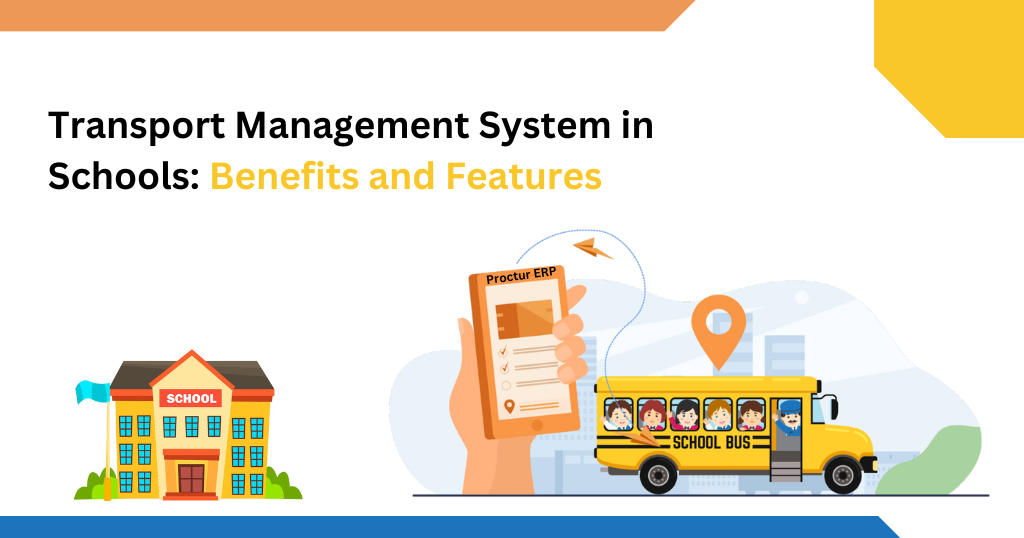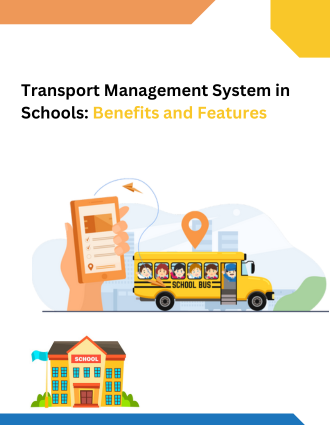Good facilities and qualified teachers are components of a high-quality education. In today’s fast-paced globe, transportation services grab a crucial spot. The days of parents searching for nearby educational institutions are long gone.
With its fleet of school and college buses, the majority of schools provide a pick-up and drop-off service. These yellow buses travel great distances to pick up employees and students. The safety of the students becomes crucial with such a huge fleet. A transport management system guarantees lower risk through strategic planning, implementation, and monitoring.

There is a lower accident rate in educational institutions that have bus tracking and management software integrated into their school management system. Because of this, it is essential that educational institutions, including colleges, choose a school management system that prioritizes student safety. Additionally, it boosts parents’ trust in the school’s procedures.
What is a Transport Management System?
A school transportation management system is a database-driven piece of software that makes managing the entire fleet of school buses easier and more effective for administrators. The majority of manual interventions are eliminated, and the school administrator receives rapid feedback on a range of parameters. With standard manual administrative procedures, these reports would have taken days, if not weeks, to complete.
An integrated end-to-end management system is produced by integrating the transport management system with the school management ERP. Daily management of data, including driver allocation and vehicle numbers, is done by the school transport software.
The school transport management system includes a payment module that provides parents with various online payment options. It makes it easier for college and school administrators to update bus prices and inform all parents of them. The admin office of the institution operates more efficiently when payment history and reminders about outstanding payments are provided.
Advantages of a Transport Management System
Because of its benefits, a transport management system is becoming more and more common at universities and colleges. Here are a few compelling arguments in favor of adopting a transport management system.
1. Improved Safety
A GPS tracker is installed on a school bus by a transport management system. This lets parents track the school bus in real-time. This helps parents know when the bus will pick up and drop off their child at school.
This helps parents schedule their time so kids get to the bus on time. The GPS tracking device can warn parents in advance of drop-off or pick-up location changes, allowing them to alter their schedule. All of this contributes to kids getting to school hassle-free and on schedule.
By assisting parents or school authorities in keeping an eye on the entire bus ride, a transport management system can increase the safety of the children inside the vehicle. The majority of schools have an app that streams live CCTV footage from buses and is connected to the transport management system.
In order to make sure they always know where the bus is and may be informed if the driver is traveling an unfamiliar or new route, the app also enables parents and teachers to track the bus route.
2. Highly Sustainable
Schools can keep track of the schedules, licenses, and profiles of each driver by using a transport management system. This feature has the following two benefits. One benefit is that parents can learn more about their child’s bus driver. This may reassure them about their child’s safety.
Its second benefit is that schools can readily rearrange driver schedules to accommodate any changes. The school administration can easily look through the schedules of other drivers to find one who is available during that time slot, for instance, if one driver is unavailable on a certain day. This can keep the school bus schedule on track and assist in avoiding delays in bus timings.
3. Better Upkeep
Every bus vehicle has a GPS tracker installed, which allows the school administration to monitor the situation in real-time and identify areas for improvement. Reports on driving habits and fuel usage can give administrative insights that improve workflow and lower costs over the long run.
Reminders for the maintenance schedule can be configured to notify the administrator when each car needs to be serviced, extending the lifespan of each one. Reminders for driving license renewals and insurance policy expirations can also be established, consolidating all of the administration related to school transportation into a single window.
Features of A Transport Management System
The initial step in the transportation procedure is to make a transport request that contains the cargo information as well as the estimate. Carriers acquire loads from shippers and must then organize capacity and freight allocation. Some of the most common features of a transport management system include:
1. Shipment Rate Management
One of TMS’s most important components is a rate engine. A rate engine calculates transportation costs for parcel, LTL, truckload, and intermodal shipments based on base rates, discounts, and contractual agreements.
A TMS should be able to create bespoke pricing rules and deliver a quote to a customer as soon as they submit their request, enabling it to handle even the most complex tariffs.
2. Fleet Management
If you own a fleet, transport management systems will enable you to view and manage all of your assets from a single platform. Although not all TMS providers have extensive fleet management tools, you may assign drivers and equipment, control dispatch, and pay drivers.
You may regulate fuel use and environmental effects, keep track of vehicle checks and maintenance procedures, and remotely drive the truck if you utilize fleet management software.
3. Load Planning
After accounting for the maximum weight and load constraints, you may arrange the area required for loading trucks, trailers, and containers and receive an estimate of the space that is available.
Master data is information that you can enter and preserve for later use, such as your car’s dimensions. The dimensions of the item are provided in the freight order. Certain school management system have a 3D load plan tool that lets you see and adjust how cargo is arranged and how much space is consumed.
Bottom Line
The implementation of a Proctur transport management system at educational institutions is deemed essential for guaranteeing the security, effectiveness, and simplified management of school transportation.
Schools that have integrated a complete transportation management system (TMS) into their management system have seen a notable decrease in accident rates, a reflection of the changing needs of parents and the growing importance of transportation services. This puts student safety first and gives parents peace of mind about the school’s dedication to a safe transportation system.



